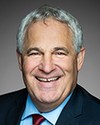Okay, I'll start off.
Good morning, chair, ladies and gentlemen, and honourable members of the standing committee. My name is Sian Barraclough and I'm vice-president, commercial and energy management, with Capital Power, headquartered in Edmonton, Alberta.
I'm also accompanied today by my colleague Steven Wollin, vice-president, engineering, for Capital Power.
Thank you for the opportunity to appear before you and to provide background on the bioenergy project we're seeking to develop at our Genesee site. We believe that using forestry residuals through projects such as ours to create electricity delivers against two key federal policy objectives: sustainability of the forestry sector and early reduction in greenhouse gas emissions. Our initiative also supports the vision of the forest bioeconomy framework for Canada announced late in 2017 by the Canadian Council of Forest Ministers.
By way of a brief background, Capital Power is a developer, owner, and operator of generating facilities across Canada and in the United States. We are a publicly traded company with a market capitalization of approximately $2.7 billion with approximately 700 employees located through Canada and in the U.S.
Capital Power currently owns approximately 4,500 megawatts of power generation capacity in 24 facilities. Our generating fleet includes a wide range of fuel types, including coal, natural gas, wind, solar, waste heat, and biomass.
Roughly 30% of our capacity is from our four coal generating facilities, all located in Alberta, and they are the youngest and most efficient coal units in the province.
Our bioenergy project is focused on the Genesee site, home to three of our coal generating facilities. The Genesee site is undergoing a transition to a lower carbon future, supported by three key activities: first, a program that we call the Genesee performance strategy, or GPS, focused on reducing emissions, which GE has stated positions Capital Power as a world leader in carbon reduction from coal plants; second, a staged approach for coal-to-gas conversion; and third, our biofuel substitution strategy.
We have already taken actions that will reduce greenhouse gas emissions through improved efficiency at our units. The GPS initiative alone will deliver an 11% improvement in emissions intensity by 2021 with the units operating as coal facilities.
In addition, we have been actively looking at replacing coal with biomass to deliver additional substantive greenhouse gas emissions reductions. As we transition the units to natural gas, the benefits of both our GPS carbon reduction program and our potential bioenergy project would be sustained.
Woody biomass residuals from existing forestry operations are a significant potential renewable energy resource that can enable a transformation of the electricity sector while helping to sustain a strong forestry sector. The phase-out of incineration of wood waste in the forestry sector has resulted in mounting inventories of wood residuals at some sites, creating a challenge for small and large forestry producers. While some of this residual wood is expected to be used in the production of wood pellets for export, there remains a significant volume of bark residuals that pelletization facilities cannot process and that could end up stockpiled or landfilled. There is sufficient capacity at the Genesee generating station to consume most or all of the surplus woody biomass volumes in Alberta. Cost-effective conversion of waste wood into bioenergy would enhance the sustainability of Alberta's mills, create new rural and indigenous jobs, and reduce methane emissions from decomposition, while also reducing greenhouse gas emissions as a result of the displacement of coal for power generation.
Capital Power has explored biomass fuel conversion options, including pelletization, and concluded that the most cost-efficient near-term means to create bioenergy from forestry residuals at our units is through a customized on-site biomass preprocessing system. This custom-engineered methodology involves drying and sizing the raw wood waste before blowing the fuel into the plant's combustion system. The initial project would allow 15% blending of biomass with coal at one of our Genesee units, while future phases could increase biofuel substitution to 30% of two units with long-term potential to have a single unit run entirely on biofuels. It is also worth noting that biomass fuel substitution could be applicable in Saskatchewan, Nova Scotia, and New Brunswick, provinces that all have important forestry sectors and legacy coal-fired generation plants.
A 15% biofuel substitution project would contribute over 600 person-years of employment, while reducing greenhouse gas emissions by 600,000 tonnes per year, the equivalent of taking 100,000 cars off the road. Coal-powered generation would be reduced by up to 400,000 megawatt hours per year, well in advance of 2030. In addition, the project would deliver dispatchable, renewable generation that would help support increased deployment of wind and solar resources going forward.
To date, we have spent over $2.2 million testing potential bioenergy options at Genesee through two rounds of testing in 2016 and 2017. The testing has proven the feasibility of our unique fuel preprocessing and conveyance approach.
Capital Power has been working closely with industry partners, including West Fraser, the Albert Forest Products Association, and Emissions Reduction Alberta, to move this opportunity forward.
Emissions Reduction Alberta has committed $5 million to the project through its methane challenge competition, a small portion of which was used to support the second round of testing in 2017.
West Fraser also actively supported the testing by providing wood residuals from its Alberta forestry operations.
As part of our 2017 cofiring test program, Alberta Innovates also provided partial funding towards the testing of an advanced solid biofuel created from municipal waste. The results of the test are promising and show that our Genesee facility may also be able to generate renewable electricity using a much wider range of waste fuels, which complements our efforts to utilize forestry residual biomass.
This biofuel substitution technology is unique relative to other low-emitting, dispatchable generation sources, such as nuclear or hydro, because it is rapidly deployable and could be operational in less than two years of an investment decision. Further, it is the lowest-cost solution that we have identified that can create near-zero GHG electricity at a fossil fuel power plant and will be less than half the cost of carbon capture and storage technology.
Although Capital Power would be able to offset a significant portion of our construction and operational cost from avoided carbon levy payment, and although this is the lowest-cost solution to create low-emission electricity at a fossil fuel plant, based on current economics, there is still a financial gap to close. Therefore, we are currently working with the Clean Growth Hub in hopes of identifying federal programming that would be the best fit to close this gap.
Capital Power is committed to a transition to a lower-carbon future at the Genesee site. While making a material contribution to that goal, this biofuel substitution project is also a unique way to improve the sustainability of the forestry sector by finding a productive use for a resource that has traditionally had low value.
Capital Power appreciates the opportunity to provide its views on this very important initiative. We welcome any questions you have.
Thank you.




